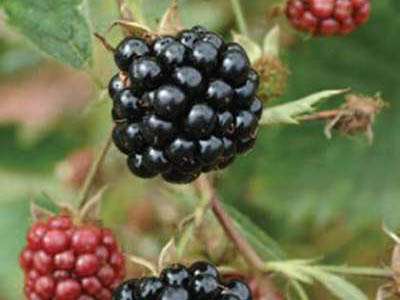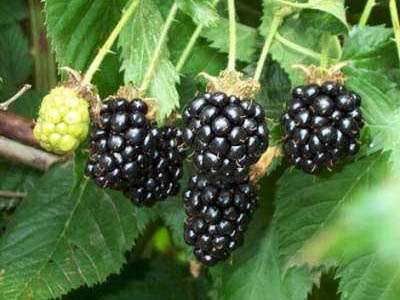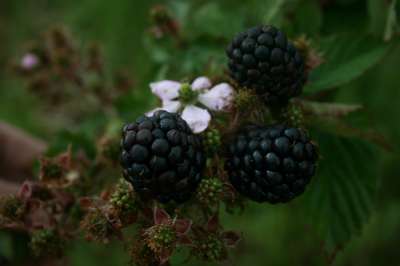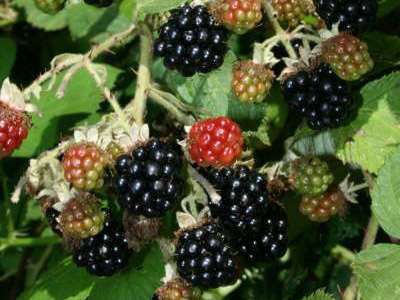Your basket is currently empty!
Loganberries and Tayberries are cultivated in exactly the same way as Blackberries so for how to grow Loganberries follow this guide. Obtain excellent plants of blackberry by clicking here.
Almost an essential element of any fruit garden is a good Blackberry. Even if you live in an area awash with wild ‘brambles’ as they are called, cultivated Blackberries are an invaluable asset for the fruits are much larger and juicier with less seeds. Plus there is a multitude of thorn free varieties that takes the pain out of harvest. You can also get a much longer season with cultivated varieties as a range of cultivars have been bred to extend the season.
Blackberry Bushes are one of the easiest of the soft fruits to satisfy and will often do well under conditions less suited to other fruit bushes. They tend to be very reliable and a good ‘bankable’ asset that can be relied upon not only for fresh fruits but with surplus suited to freezing and jam making. They will for example tolerate a degree of shade which is intolerable to many fruit plants. With much publicity related to the fruits ’superfood’ status the cost of shop-bought blackberries has rocketed along with it’s popularity. As it is such a simple affair to grow your own a few well chosen plants represents a very sensible investment that can reward for up to 20 years.
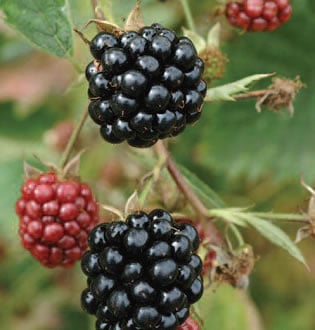
Blackberry plants – uses in the garden
Although the majority will be looking for traditional use in the fruit garden, it might come as a surprise that these are versatile plants with a number of less obvious applications in the garden.
For fruiting arches and pergolas
There is no reason why a Blackberry should not be used to utilize an arch, pergola or arbour, particularly if the smooth stemmed varieties are chosen. It is quite easy to train the long flexible canes in and one plant either side of an 8’ arch is ample. Crops can be very heavy and if you have more than one arch then a ‘tunnel’ can be created. Under such circumstances the Blackberries can be grown in conjunction also with Loganberries and Hybrid Berries if desired, or you can grow a variety of Blackberries to cover the available fruiting season. With the benefit of so many completely thorn-free selections, you can walk through fearless of being scratched. An added virtue is that in many parts of the country the Blackberry is almost evergreen, or semi evergreen and keeps some foliage in all but the severest winters, making your fruiting arch a permanent feature even in the winter.
Planting for the wildlife
No other fruiting plant is more wild-life friendly. The blossoms are extremely attractive to bees and they can range in colour from pink to rose to white. The thick growth can provide a valuable nesting site to birds and the fruits of course are also much favoured by birds and also late butterflies.
Use as ground cover
Although normally the Blackberry is grown with support, and this continues to be recommended for ease of harvest and quality fruits, the plants do not have to be grown in such a way. They can be grown as self supporting, the long canes arch over and will in a short time cover the ground most effectively. Some of the fruits will be out of reach so this isn’t to be recommended where fruit production is of paramount importance, but if you have an area you want covered with something that is undemanding and easy to grow yet functional as well, then the Blackberry is an ideal choice. Again thorny and thorn free varieties would be suitable, or for a less enthusiastic grower why not choose from the more compact varieties? Loch Ness and Waldo can eb set just 4’ apart and allowed to grow together. Both are smooth of stem. More traditional varieties will require a spacing of 6-8’ for this purpose and the canes won’t be quite as low but cropping will be more abundant especially calculated on a square yard basis. Blackberries used as ground cover can cope with semi shade as well as full sun and will also become a haven for nesting birds and wildlife.
Blackberries as wall cover
Any aspect is suitable and when you compare a Blackberry with your average higher maintenance beautiful but ultimately useless climber [clematis, roses, honeysuckle etc] then the Blackberry has a good many virtuous qualities. You might want to select the Oregon Thornless variety which has pretty deeply cut leaves which become tinted with wine and orange in the Autumn. It is such a decorative variety yet it is no slouch when it comes to fruit production and the berries are sweet.
Blackberries as an intruder proof hedge or barrier
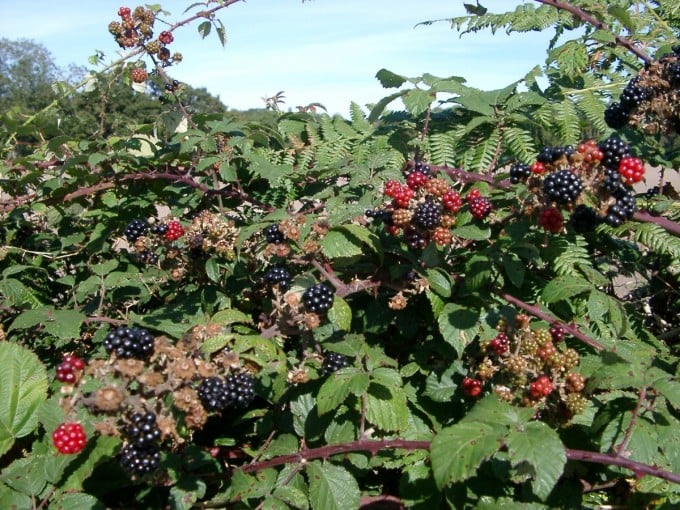
If there is a virtue to that impenetrable mass of thorns and prickles it is that it is so unfriendly it can be used to great advantage as a perimeter hedge or barrier to people or animals. Many farmsteads keep their bramble hedges as the most effective means of keeping their properties intruder proof. Some initial training might be feasible to get the plants going in the manner you want them to but thereafter it is best to let them go and do what they want, you will then end up with the impenetrable mass that you desire. The variety Himalayan Giant is by far the most popular choice for this application as it is the most vigorous, but John Innes, Bedford Giant and Ashton Cross can also be considered. Plus you can harvest a really good crop of fruits too. Planting can take place at the standard distance of 8-10’ if you don’t mi nd waiting a bit, but you can also plant at a higher density for quick effect and an even more impenetrable barrier.
Choosing the best situation
Because of it’s easier going nature it is often the case that the Blackberry ends up with the least promising position in the garden and certainly they will usually cope and provide a worthwhile crop just the same. But if you want to get the best yield of plumpest, sweetest berries, then afford some sunshine and a decent soil that isn’t prone to drying out. Make sure there is room – often they will surprise you and if you end up with a plant you keep having to cut back to keep it within bounds then the fruiting capacity will be compromised. Soil ph is largely unimportant as is the quality as long as it isn’t bone dry or prone to waterlogging. The plant is hardy throughout the country and winter protection isn’t something that needs to be considered [I only mention this because I did share correspondence with a gardener recently who thought that Brambles would not grow in Scotland]
Growing Blackberries in containers
Growing Blackberries in containers is perfectly feasible but avoid the more vigorous cultivars. Go for the naturally compact Waldo, Loch Ness or the intermediate growers such as Merton Thornless and Loch Tay. The former will do well in an 18” container for many years, for the latter I would go for a 24” pot. Proprietary all purpose compost is fine. The plants can be left in these containers for 4-5 years and then re-potted with fresh compost. An annual feed can take place with a single Osmocote tab which is a slow release fertilizer that keeps on giving over an entire growing season. Alternatively you might wish to use Seaweed extract such as the brand Maxicrop which I always favour because it seems to impart a rich green foliage colour and works quite quickly and is safe and easy to use diluted in water and applied direct to the roots or used as an overhead foliar feed.
The taller growing kinds will need supporting with a single post or a trio of bamboo canes tied together wigwam effect. Waldo and Loch Ness can be grown as self supporting. Even the more traditional vigorous growers can be utilized in larger containers but will be harder to control.
Wherever you site try to avoid an open or windswept position as there is nothing more irritating than forever picking up pots blown over by the wind. Remember your Blackberry will get quite top heavy especially during the summer when established. Such an aspect will also result in faster drying out and more watering. Which brings us to irrigation! For the best quality fruits don’t stint on the water! Puddle in the containers each day unless it has rained copiously which is an important consideration for light rain probably won’t reach the roots as the foliage will shield the compost from it. For ease of application you can sit the container in a tray and simply fill that with water each day. This facilitates easy uptake by the roots. Water saving crystals or gel can be incorporated at potting time and are said to help conserve moisture.
A sunny or partly sunny aspect is desirable for your pot grown Blackberry.



